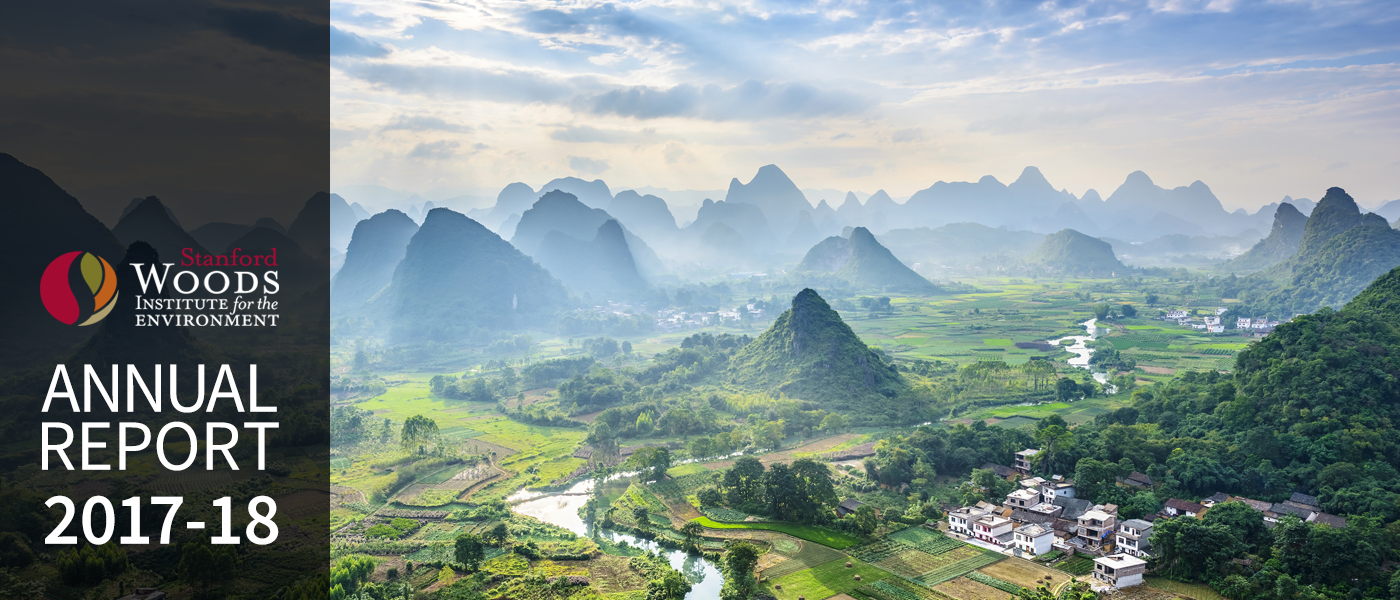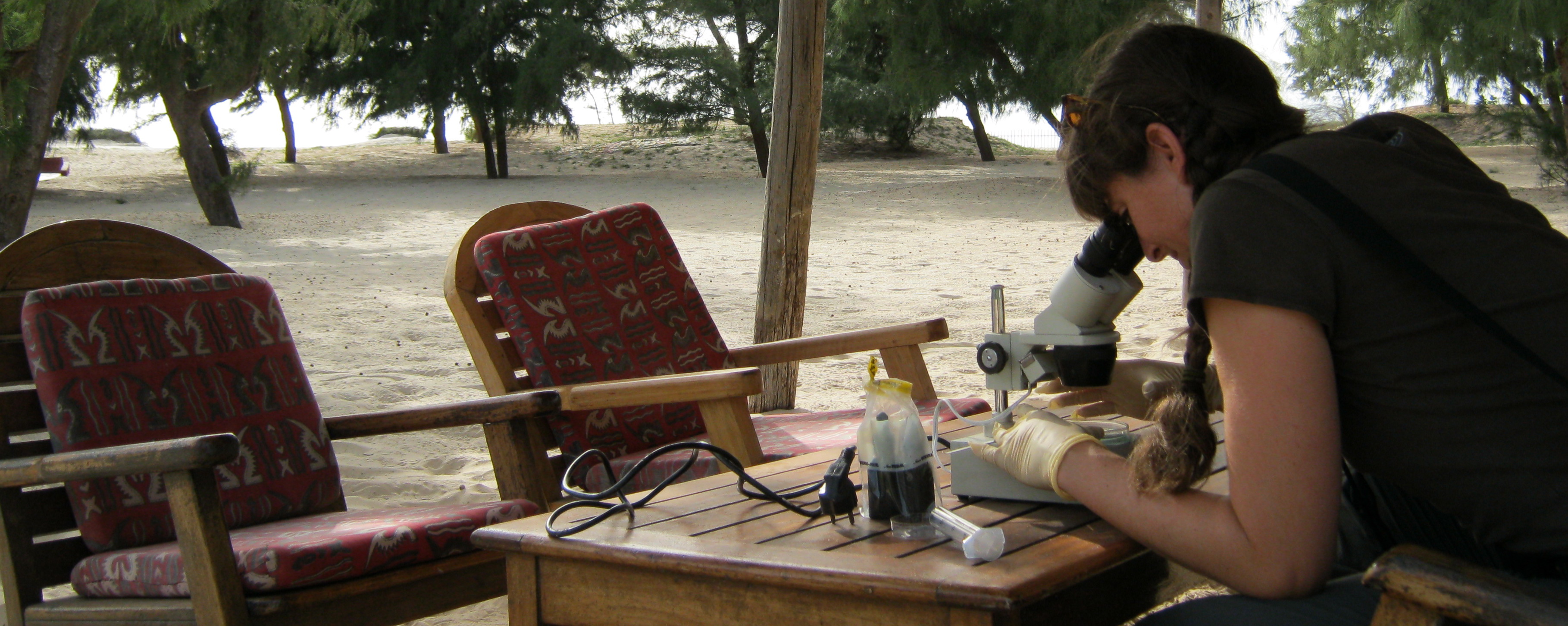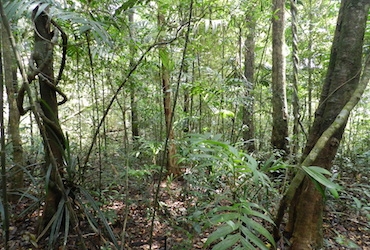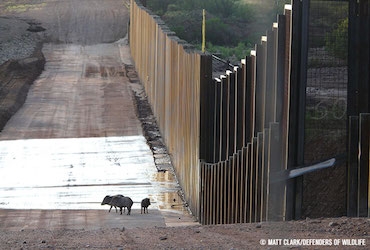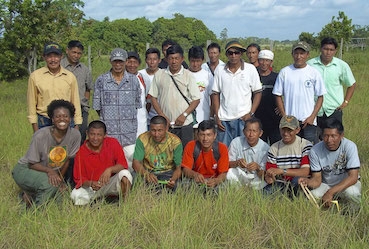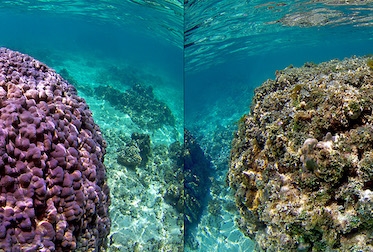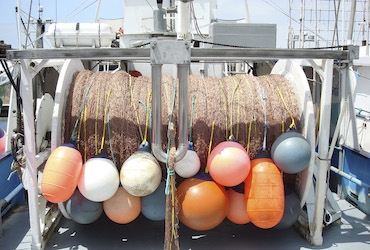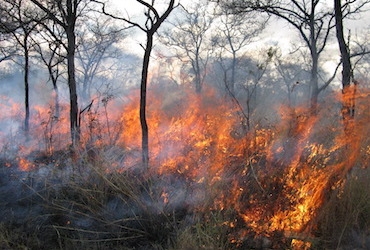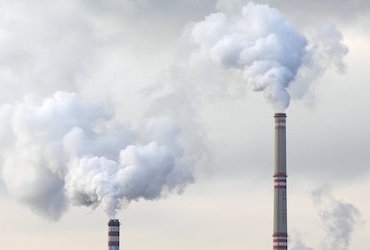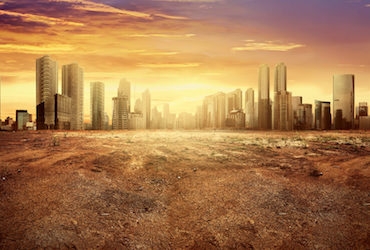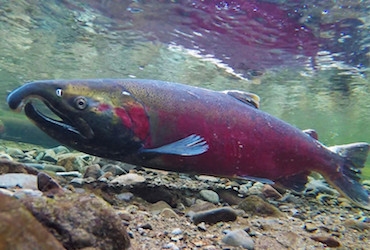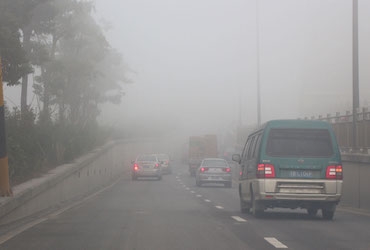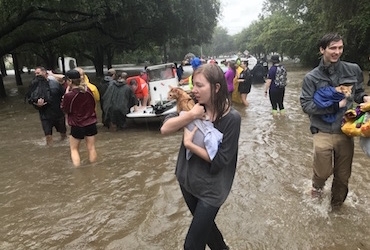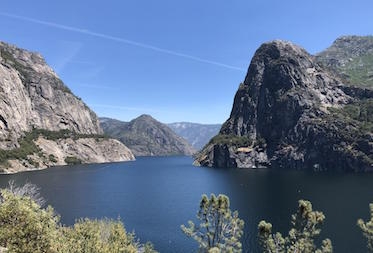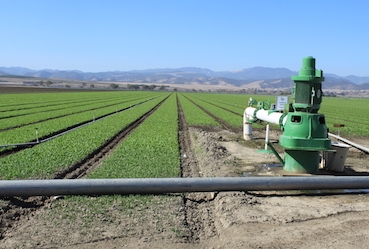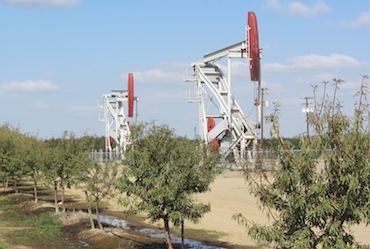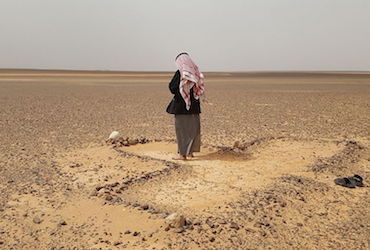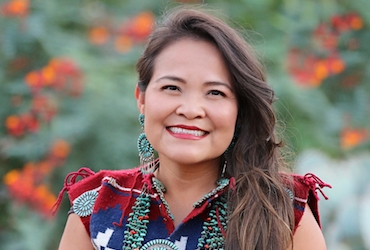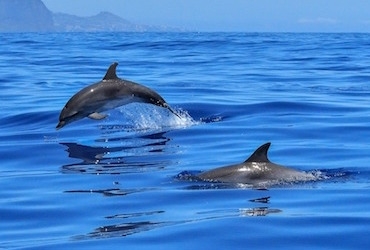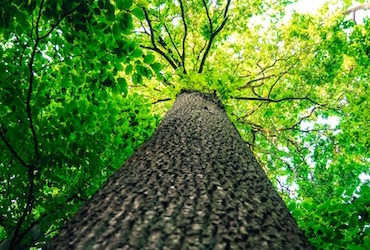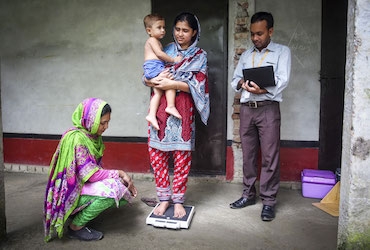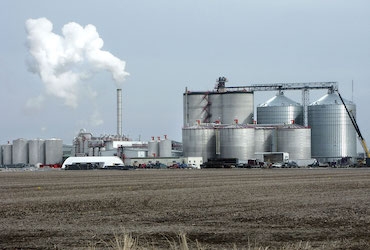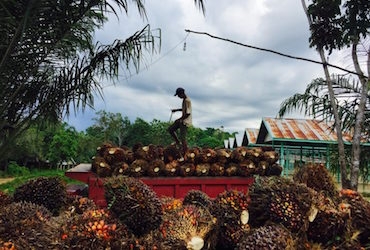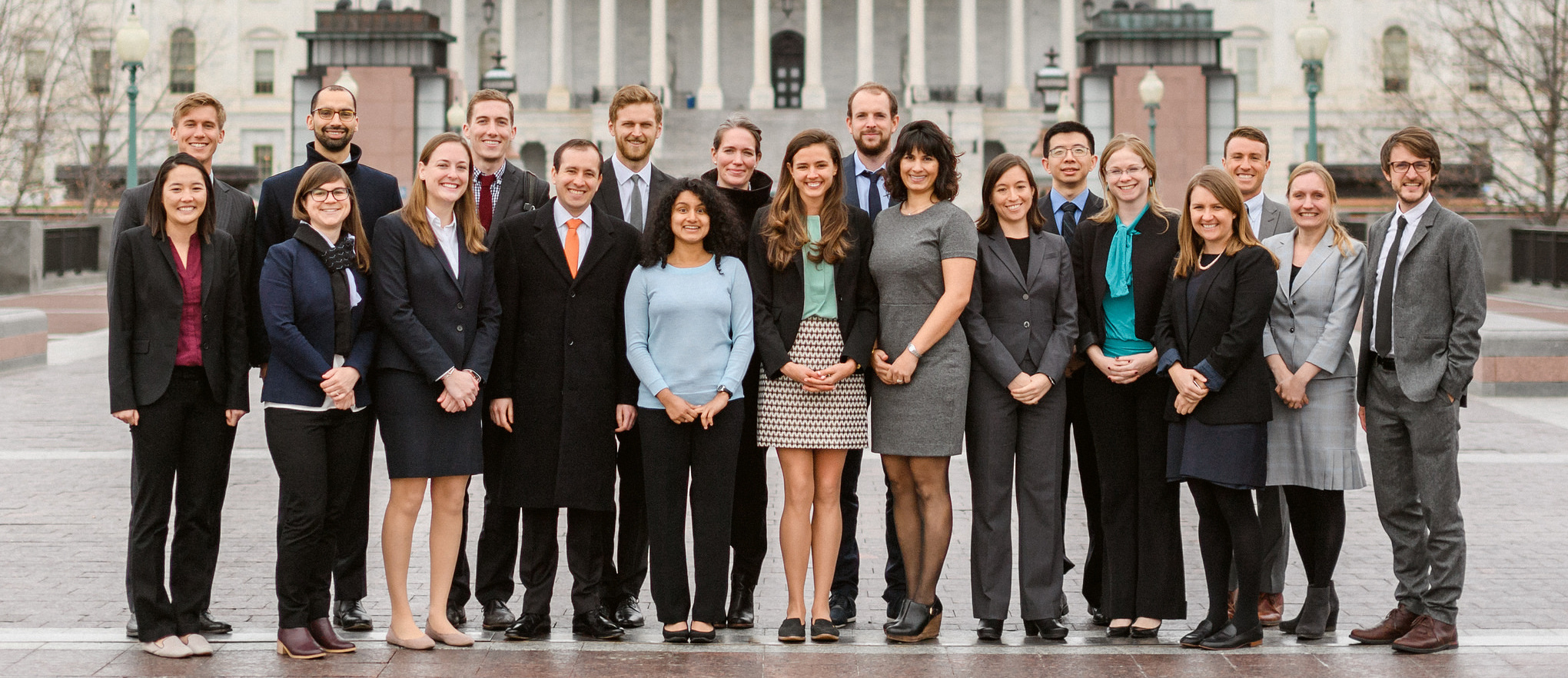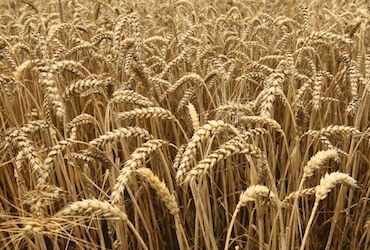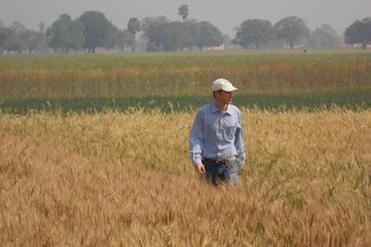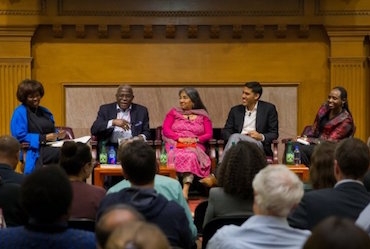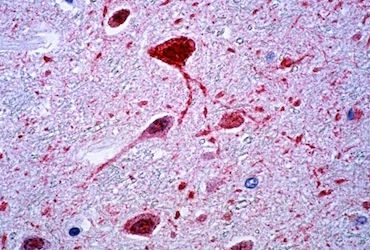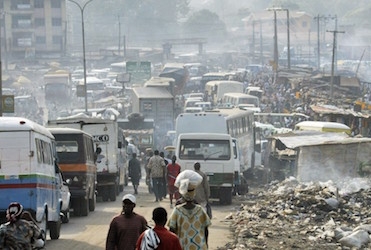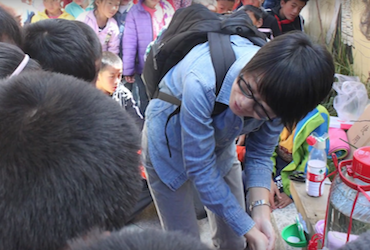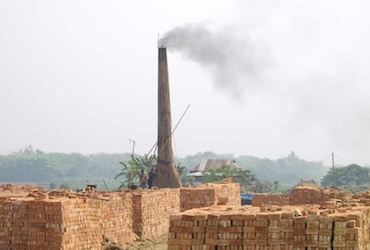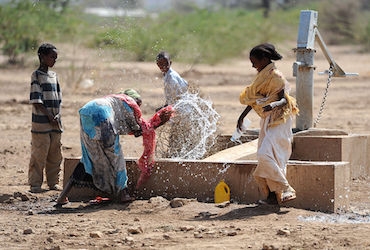A Word from Director Chris Field

Dear Friends,
We’re focused on understanding environmental challenges and delivering solutions at scale. For me, this means building bridges and collaborations across disciplines and linking research, communication, and implementation. We’ve continued to have real successes in understanding not only the essence of environmental problems, but also the pathways to meaningful solutions.
Over the past year, Stanford researchers have published remarkable findings on the link between infant deaths and air quality. They’ve traced sources of dangerous chemicals in our water to industry and natural sources. Their work shows how the jet stream can operate in two fundamentally different modes, with deep implications for how the climate works and climate change unfolds. And they’ve proven the efficacy of protecting marine areas from overfishing. As we explore next steps of connecting that research to action, newly funded projects are developing fire retardants that reduce the risk of wildfire as well as equations that allow insurance companies to write good policies for coastal risk.
Advancing knowledge and solutions requires more than technical skills. Researchers need people skills for building and leading effective collaborations and for communicating results. This year, we’ve launched a program aimed at honing those skills among our inaugural cohort of Leading Interdisciplinary Collaborations (LInC) fellows. These outstanding faculty members have shown a great commitment to environmental leadership, and to raising their skill level through training the fellowships provide.
The real goal of the Stanford Woods Institute for the Environment is to continue to provide practical solutions for people and the planet. We deeply appreciate all you do to help support and contribute to that effort and look forward to what we’ll accomplish together in the year to come.
Chris Field
Perry L. McCarty Director
Spotlight
Inclusive, Green Growth
With China committing more than a trillion dollars to securing the environment, new science is needed for targeting these investments. The ongoing collaboration between the Chinese Academy of Sciences and the Natural Capital Project entered a new phase in advancing approaches to sustainable, inclusive growth. The partnership will focus on achieving the “Chinese Dream” of becoming an ecological civilization, using real-time data streams on ecosystems to quantify nature’s benefits to people across the nation. In a Woods Conversation, Co-director of the Natural Capital Project and Blue Planet Prize winner Gretchen Daily (H&S) and Jim Leape, Co-director of the Center for Ocean Solutions, discussed the transformative approach and its adoption by China and other countries. Read More...
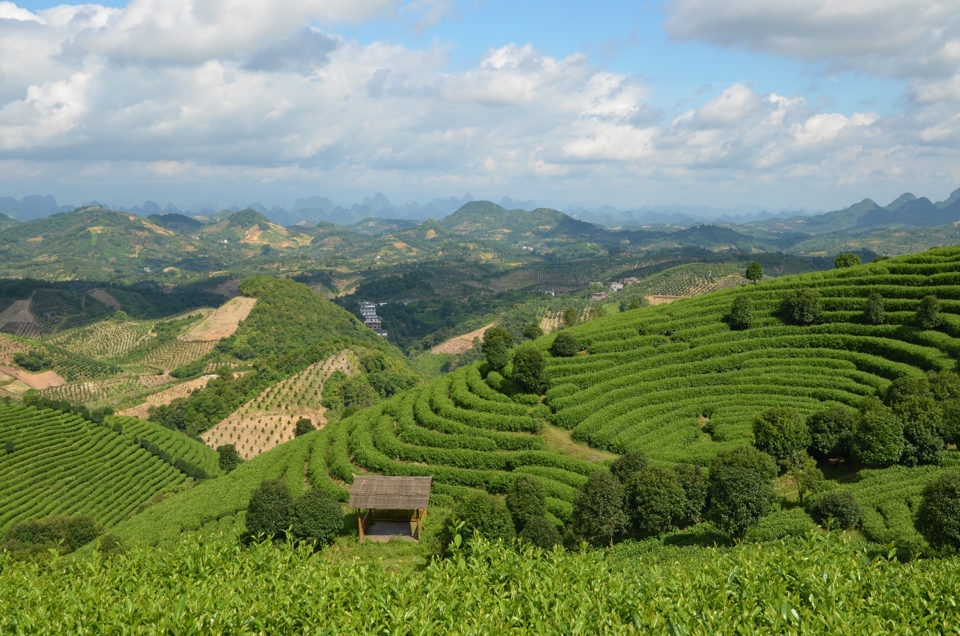
Amid expanding political polarization and distrust of traditional information sources, one thing is clear: evidence-based scholarship is more important than ever.
At Woods, we are finding new ways to open conversations, include diverse perspectives and foster collaborations needed to fuel discovery. Perhaps the best example of this is our approach to grant-making via Environmental Venture Projects (EVP) and the Realizing Environmental Innovation Program (REIP). Both programs provide funding for interdisciplinary research needed to solve major environmental problems. Such problems—ranging from long-neglected tropical diseases to drought-fueled wildfires—are too complex to be solved by any one discipline alone.
Woods prioritizes funding interdisciplinary projects that have the potential to make significant strides in addressing such multifaceted challenges. Most academic funding opportunities emphasize established expertise and take a conservative approach, resulting in incremental studies along well-worn paths of inquiry. EVP and REIP have taken a different approach, encouraging researchers to think boldly about new topics and new approaches, placing a premium on thinking outside disciplinary traditions and encouraging broad conversations. Since the EVP program began in 2004 and the REIP program began in 2015, Woods has awarded more than $14.5 million in grants to 94 research teams representing all seven of Stanford’s academic schools.
This past year, Woods awarded more grant money than ever before. Stanford engineers, geophysicists, disease ecologists, musicologists and others received essential support to collaborate on bold initiatives such as finding new ways to detect and reduce wildfire risk, harness the sun’s power to purify water and interpret ocean health through sound. Woods continues to seek out more effective uses for its EVP funding. In its second year, a pilot program to offer small awards of up to $50,000 per project has enabled EVP to be more nimble in identifying and supporting important, lower-cost projects.
This option has also allowed the program to fund discrete components of emerging research programs. Beyond grantmaking, we have expanded our community of affiliated faculty and increased the number of events on campus where faculty, research staff and students from all seven schools can meet and learn about opportunities for collaboration.
Our new “Conversations With...” series brought a range of experts, including the former U.S. under secretary for science and energy, the chair of the U.S. Arctic Research Commission and the head of the world’s largest scientific society to campus. Hosted by Woods Director Chris Field, the wide-ranging discussions explored the who, how and why of major developments in environmental science and policy, and included significant time for interactions with the audience. In partnership with Stanford’s department of economics, Woods debuted a new spin on its Environmental Forum. The Environmental Economics Forum featured insights from leading economic thinkers at MIT, Yale, the University of Chicago and other institutions on topics such as near-term policy priorities to enable radical decarbonization and the economics of adaptation to climate change.
The environmental news highlights interspersed throughout this report feature Woods-affiliated faculty, research staff and students from across Stanford’s seven schools. When noting affiliations, we abbreviate some Stanford school names, including Graduate School of Business (GSB); Graduate School of Education (GSE); School of Engineering (SOE); School of Humanities and Sciences (H&S); School of Earth, Energy and Environmental Sciences (SE3); Stanford Law School (SLS) and School of Medicine (Med). See full news coverage spanning the past year on our website: woods.stanford.edu.
Highlights
Industry pledges of ensuring zerodeforestation in their supply chains often fall short of meaningful impact according to a study led by George and Setsuko Ishiyama Provostial Professor Eric Lambin. Their research indicates several policy approaches can make zero-deforestation initiatives more effective, equitable, tailored to local contexts and verifiable. Such approaches include: endorsing and reinforcing company standards; sharing related information with companies, and covering compliance costs for small producers.
A continuous wall along the U.S.- Mexico boundary would threaten the existence of numerous plant and animal species, explained Senior Fellows Paul Ehrlich and Rodolfo Dirzo when discussing the region’s unique natural ecosystems and the species that could be lost.
More than a million records of animal sightings and activity collected by 340 indigenous technicians in the Amazon underpin findings that animal diversity is correlated with places that have the most carbon sequestered in soil. The study coauthored by Bing Professor of Environmental Science Rodolfo Dirzo suggests that large animal diversity influences carbon stocks and contributes to climate change mitigation.
Just five countries account for over 85 percent of high seas fishing. This surprise and more were discovered by a team of researchers, including Barbara Block, the Charles and Elizabeth Prothro Professor in Marine Sciences. The study directly quantified industrial fishing’s footprint using satellites and onboard ship-locating technology. Thanks to the research, daily maps of global fishing are now publicly available through globalfishingwatch.org.
As temperatures rise, coral in Hawaii are struggling to recover from bleaching events. To understand which factors had the biggest impacts on these corals, researchers from the collaborative Ocean Tipping Points project, co-led by Senior Fellow Larry Crowder, completed the first-ever comprehensive map of how both humans and natural events influence reef health.
Across the world, fishing fleets discard as many as two out of five sea creatures they catch. A new software tool called EcoCast, developed by Woods Visiting Scholar Elliott Hazen, Edward Ricketts Provostial Professor of Marine Ecology and Conservation Larry Crowder and others combines satellite data of ocean conditions, records from fisheries observers and species tracking data to pinpoint ideal fishing areas on a daily basis. Resource managers can then target the most abundant fishing grounds and reduce catch of unwanted or protected species.
Looking at soil carbon storage in different ecosystems over 65 years, an interdisciplinary team of researchers from eight institutions across the world led by Michelle and Kevin Douglas Provostial Professor Rob Jackson (SE3) found frequent burning over time reduces the amount of carbon and nitrogen stored in soils of savanna grasslands and broadleaf forests. This work emphasizes the need for more research into how soil could mitigate global warming, improve crop yields and increase resilience to extreme weather.
How could a carbon tax in the United States be fair to both industries and citizens? In their new book, “Confronting the Climate Challenge,” Shuzo Nishihara Professor in Environmental and Resource Economics Larry Goulder (H&S) and co-author Marc Hafstead examined a range of U.S. climate policy options and identified policies that are low cost to the economy as well as fair in distribution of economic sacrifices.
What is the economic impact of a changing climate? Examining the correlation between past economic performance and temperature, a study led by Center on Food Security and the Environment Deputy Director Marshall Burke (SE3) found that failing to meet the U.N. Paris Agreement climate ;mitigation goals could cost the global economy tens of trillions of dollars over the next century. These projected costs include increased spending to address extreme events. Another study led by Kimmelman Family Senior Fellow Noah Diffenbaugh (SE3) showed that even a 1 degree Celsius difference could increase the likelihood of unprecedented extreme events.
California's years of drought and its impacts on farmers have raised concerns that efforts to protect fish species have played a role in limiting water deliveries to irrigators. Leon Szeptycki, Executive Director of the Water in the West program, discussed the false choice between fish and people. California can protect the environment and farmers buy building infrastructure to increase groundwater recharge capacity, according to Szeptycki.
After a three-year respite, global fossil fuel emissions are rising again according to a series of reports from the Global Carbon Project, a group chaired by Senior Fellow Rob Jackson (SE3). New fossil fuel operations in China were a leading cause of the increase. Despite the findings, improved energy efficiency and a booming renewables market are providing signs of hope.
In wake of Hurricane Harvey, Stanford experts described how climate change and infrastructure planning contribute to the severity of impacts from extreme events. Hurricanes highlight the importance of climate assessment. A review by SE3 researcher and Director of the Stanford Environment Assessment Facility Katharine Mach and Woods Director Chris Field (SE3/H&S) took a deep dive into the process of assessment of major environmental issues.
Choices made locally can have impact around the world.
On topics ranging from climate change to food and water security to global health, Woods works to provide policymakers and other leaders with unbiased findings and analysis to inform decisions across the government, corporate and nonprofit sectors.
We connect research to action. We do this by facilitating scholar engagement in policy hubs like Washington, D.C. and Sacramento, and by convening key stakeholders for workshops, dialogues and conferences that inform agendas for researchers, resource managers and practitioners. Through our public briefings, forums, media relations and other external engagement, we make the most up-to-date environmental knowledge broadly accessible to those who can use it.
Demand for Stanford expertise and insights is increasing as the public and private sectors grapple with environmental challenges exacerbated by a changing climate and growing population. What new policies and programs should governments and the private sector invest in? How can we scale and deploy solutions beyond the bench?
Examples of how Stanford experts are responding to those questions can be found at events like our recent Washington, D.C., forum on carbon removal as a climate adaptation tool.
The world is unlikely to meet the Paris Climate Agreement goal to limit warming below 2 degrees Celsius without “negative emissions” or the removal of carbon dioxide from the atmosphere. That technology can be harnessed today, according to new research by Stanford Earth scientists Chris Field, Katharine Mach and Sally Benson. They briefed legislative staff and energy policy analysts on the economic and scientific potential for bioenergy carbon capture and sequestration and other carbon removal options in the United States.
In Sacramento, Woods organized a policy forum in response to California’s growing wildfire threat. In a year that saw both the state’s largest and most destructive wildfires in history, Stanford experts addressed state officials charged with preparing for and responding to these disasters. Woods brought together Stanford experts, including Earth System Science Professor Noah Diffenbaugh and Naddisy Foundation Professor of Pediatric Food Allergy, Immunology and Asthma Kari Nadeau, with California State Assembly member Bill Quirk to discuss the growing threat of wildfires in California and what it means for managing the state’s forests and public health.
Likewise, as sea levels rise, coastal communities find themselves on the front line of a changing climate. In 2017, practitioners from diverse institutions and fields joined scholars from Woods, the Center for Ocean Solutions, the Natural Capital Project, the Hoover Institution and the Woodrow Wilson Center for a series of workshops and forums to highlight pressing challenges and risks to the world’s coasts and U.S. security. The Building Coastal Resilience series featured Stanford scholars and other experts discussing how to best address these challenges through policy, technology and research. Organizers of the series—held in Washington, D.C. and on campus—produced a white paper, “Building Coastal Resilience for Greater U.S. Security.” The paper explores challenges facing coastal communities and ways to advance U.S. resilience to climate change impacts, strengthen the sustainability and economic security of coastal infrastructure and enhance national security.
These events are emblematic of an even greater commitment by Stanford scholars who consistently strive to link environmental knowledge to solutions. Whether they are briefing leaders one-on-one or producing op-eds read by millions, they realize the value of translating and contextualizing their findings for audiences outside the lab and around the world.
Highlights
How can we incentivize water conservation efficiently? Research by the Water in the West urban water policy team proposed a cap-and-trade approach to water conservation based on local supply and demand realities. Looking at 26 communities in the Bay Area, the researchers explored how a system of tradable credits might allow utilities to meet their conservation goals.
Alletta (Letty) Belin, former Counselor to the Deputy Secretary of the Interior and an expert in water law and management, joined Stanford as a Landreth Visiting Fellow working with the Water in the West Program. While at Stanford, Belin produced a guide for implementing California’s Sustainable Groundwater Management Act and discussed recommendations on improving U.S. Army Corps of Engineers reservoir management practices.
How close is too close for hydraulic fracturing? A study coauthored by Debra Perrone, formerly a postdoctoral scholar with Water in the West and now an assistant professor at UC Santa Barbara, showed more than half of hydraulically fractured wells lie within 2 to 3 kilometers of a domestic groundwater well potentially close enough for contaminants to enter drinking water.
Jordan is among the world's most water-poor nations, and its situation could get worse in the future. An analysis of regional drought and land-use changes by Cyrus Fisher Tolman Professor Steven Gorelick (SE3) found the country could face lower rainfall, much higher temperatures and as much as a 75 percent decline in water flowing into the country from Syria in the aftermath of the civil war
Years of drought in California highlighted the need for information on how much water conversation was happening at the regional level. Using a new web-scraping and search algorithm and water utility data, research led by Newsha Ajami, Director of Urban Water Policy at Water in the West and NSF ReNUWit, showed a link between media attention to drought and household water savings. Ajami's team also created a web portal that allows people to interact with drought data as well as track drought-related media and public interest.
Abandoned mines are a huge issue for water quality across the western U.S. Karletta Chief, Assistant Professor of Soil, Water and Environmental Sciences at the University of Arizona, spoke at Stanford about her work with the Navajo Nation and integrating Indigenous knowledge with rigorous scientific study regarding the Gold King Mine Disaster which sent 190 tons of heavy metals and other contaminants into a tributary of the Animas River.
In an effort to bring together scientists across fields focused on oceans and climate, COS co-organized the Ocean Visions Initiative, a series of events highlighting successful ocean initiatives with the Smithsonian Ocean Portal, Georgia Tech's Ocean Science and Engineering Program and the Scripps Center for Climate Impacts and Adaptation. COS is also working with Friends of Ocean Action, a global initiative created at the invitation of the United Nations Secretary General's Special Envoy for Oceans to help conserve and sustainably use the world's oceans.
A pioneering California program to allow forest owners around the United States to sell carbon credits to companies was found to have not only reduced emissions, but had the added benefit of providing habitat for endangered species. The research provides lessons for similar initiatives under development in other states and countries.
Led by Stanford Medicine professor Stephen Luby, a study in Bangladesh revealed that improving water, sanitation and hygiene in poor regions helped overall health but, contrary to expectations, did not improve children’s growth and development. Though disappointing, the findings increase knowledge surrounding water, sanitation and hygiene interventions and child health.
The world is unlikely to meet the Paris Climate Agreement goal to limit warming below 2 degrees Celsius without “negative emissions,” or removing carbon dioxide from the atmosphere. Melvin and Joan Lane Professor for Interdisciplinary Studies Chris Field, Senior Research Scientist in Earth System Science Katharine Mach, Precourt Institute for Energy Co-Director Sally Benson and others contributed to a series of papers explaining the economic and scientific potential for bioenergy carbon capture and sequestration and other carbon removal options in the United States. The Stanford Earth experts also met in Washington, D.C., for a policy forum to discuss carbon removal in the climate response portfolio.
The Program for Disease Ecology, Health and the Environment, a joint initiative of the Stanford Woods Institute for the Environment and Stanford’s Center for Innovation in Global Health, launched a new website to explain its work with experts in public health, ecology, engineering, computer science, medicine and the social sciences on sustainable environmental interventions for a range of diseases.
The first large-scale analysis of corporate practices for sourcing sustainable materials showed that many companies address sustainability at some level, but most deal with only one or a subset of materials in their supply chains. Companies on the receiving end of consumer and civil society pressure, however, are significantly more likely to adopt at least one sustainable sourcing practice.
We live in the Anthropocene—an era of massive, widespread human impacts on the natural world.
To find solutions to complex environmental challenges, researchers must cross sectors and disciplines on- and off-campus. Yet, many scholars find traditional academic training hasn’t equipped them with the tools and perspectives needed to transcend these boundaries. Woods is helping connect knowledge to action through innovative approaches to collaboration.
Central to this effort is the Leading Interdisciplinary Collaborations (LInC) program. Launched this past year, LInC coaches early- and mid-career Stanford faculty on collective leadership, an approach that inverts traditional academic norms of one-way knowledge sharing. The approach harnesses the strengths of a group, whether it’s in the lab or in the field where researchers are teaming up with stakeholders to solve real-world problems. It values working together over status or roles, empathy over certainty, and diverse stakeholders over experts. In this model, a leader mobilizes a group to action by steering people toward a shared vision.
The inaugural LInC cohort is piloted by faculty with a strong dedication to and clear results in leadership, outreach and collaboration. They come from Stanford’s schools of education; earth, energy & environmental sciences; humanities and sciences; engineering; and medicine. Through an initial three-day retreat followed by regular gatherings, LInC will create an environment that allows faculty to reflect, ask questions, take risks, experiment and practice new leadership, collaboration and systems thinking skills. To develop next-generation change makers, Woods offers graduate and undergraduate students education and support to advance their research and maximize its real-world impact. This past year, Woods added a major government agency partner to its Environmental Policy Internships in California (EPIC) program, centered its Forum for Undergraduate Environmental Leadership (FUEL) around a singular issue, and expanded the bipartisan reach of its Rising Environmental Leaders Program (RELP).
EPIC, offered in collaboration with the Haas Center for Public Service and Stanford in Government, provides undergraduates with paid summer internships that include mentoring from environmental professionals and directly contribute to solving important sustainability challenges facing the public. In 2018, the California Ocean Protection Council joined our list of state agency partners, which includes the Governor’s Office of Planning and Research, the Department of Conservation and the Department of Fish and Wildlife. We placed Stanford undergraduates into internships at each of these agencies.
FUEL allows Stanford undergraduate and co-terminal students from any discipline or school on campus to investigate environmental career opportunities by connecting with emerging leaders and seasoned professionals in the private and public sectors. The spring 2018 program emphasized state water issues and the WaterFix policy proposal. On-campus salons featured speakers working on related issues. Participants also visited policymakers in Sacramento and stakeholders in the SacramentoSan Joaquin Delta.
RELP helps graduate students and postdoctoral scholars in diverse fields understand how their research relates to governance, industry and, eventually, the lives of everyday people. A key component of the program is its D.C. Boot Camp, an intensive weeklong experience in Washington, D.C., that introduces fellows to legislative, government and nonprofit professionals. We continue to expand the number of meetings with Stanford alumni in government and Republican officials on the Hill.
Do companies’ claims about sustainable products hold up to scrutiny? In one of the first analyses of a company-led sustainability program in the food and agriculture sector, researchers led by Senior Fellow Eric Lambin (SE3) found a major grocery chain in South Africa fostered increased adoption of environmental practices at the farm level.
William Wrigley Senior Fellow David Lobell (SE3) was named the Gloria and Richard Kushel Director of the Center on Food Security and the Environment (FSE). Lobell succeeds William Wrigley Professor of Earth System Science Rosamond L. Naylor (SE3) who has been director since FSE’s inception in 2005.
Food security experts from the Alliance for a Green Revolution in Africa (AGRA) gathered for a symposium at Stanford hosted by FSE to discuss transforming food production in Africa. Panelists included Rwanda’s former Minister of Agriculture and Animal Resources, the president of the Rockefeller Foundation and a past president of the International Fund for Agricultural Development. The experts examined the challenges, strategies and possible solutions for catalyzing and sustaining an inclusive agriculture transformation in Africa.
With a mortality rate of up to 70 percent and no vaccine or cure, the Nipah virus is the latest candidate for a global pandemic. Senior Fellow and Nipah expert Stephen Luby (Med) co-authored work linking changes in temperature with the virus’s spread from bats to humans and examined the impact of behavioral changes that reduce the likelihood of people getting the disease.
In sub-Saharan Africa, air pollution led to nearly 450,000 otherwise preventable infant deaths in 2015, according to a study led by Center Fellow Marshall Burke, (SE3). The research team compiled data from 65 household surveys across 30 sub-Saharan African countries spanning 2001 to 2015. Using new satellite-based measurements, they compared the particulate matter each infant was exposed to while in utero and after birth. From this, they could relate exposure to particulate matter with health outcomes. The analysis found that modest improvements in air quality could lead to substantial reductions in infant mortality in developing countries.
Tapeworm infection from eating contaminated pork can damage the brain, cause learning impairments, and reinforce cycles of poverty. Research in China revealed for the first time high levels of infection among schoolage children. Potential solutions to reduce infections and improve education outcomes included community education, distributing medication, and improving hand-washing facilities in schools.
Air pollution from poorly regulated brick kilns kills thousands of people every year in South Asia. With funding from an Environmental Venture Project grant, an interdisciplinary team of researchers combined satellite data and political persuasion to track kilns, raise public awareness and incentivize kiln owners to use cleaner technologies.
Up to half of all water and sanitation systems in developing countries fail after five years. To improve access to safe, reliable and affordable water services, the Conrad N. Hilton Foundation awarded a four-year $1.9 million grant to Stanford’s Program on Water, Health & Development directed by Higgins-Magid Senior Fellow Jenna Davis (SOE).
Ertharin Cousin, former U.S. Ambassador to the UN Agencies for Food and Agriculture and World Food Programme Director, joined Stanford as the Frank E. and Arthur W. Payne Distinguished Lecturer at the Freeman Spogli Institute for International Studies and Visiting Fellow at FSE. Cousin hopes to foster a unique collaborative opportunity to expand her work on food security and nutrition issues.
Spotlight
Celebrating Y2E2
Supporters of Stanford’s pioneering environment and sustainability research gathered for the tenth anniversary of Y2E2—the university’s landmark Yang & Yamazaki Environment & Energy Building—in June. The LEED Platinum-certified building, which set a new standard for building construction on campus, anchors the Science and Engineering Quad and houses the Stanford Woods Institute for the Environment. The building’s namesake donors, Jerry Yang and Akiko Yamazaki, continue to serve as active advisers and supporters of our efforts. We’re grateful for all they and other Y2E2 donors have done over the years to provide a home for Stanford’s interdisciplinary collaboration on the development of environmental knowledge and solutions.
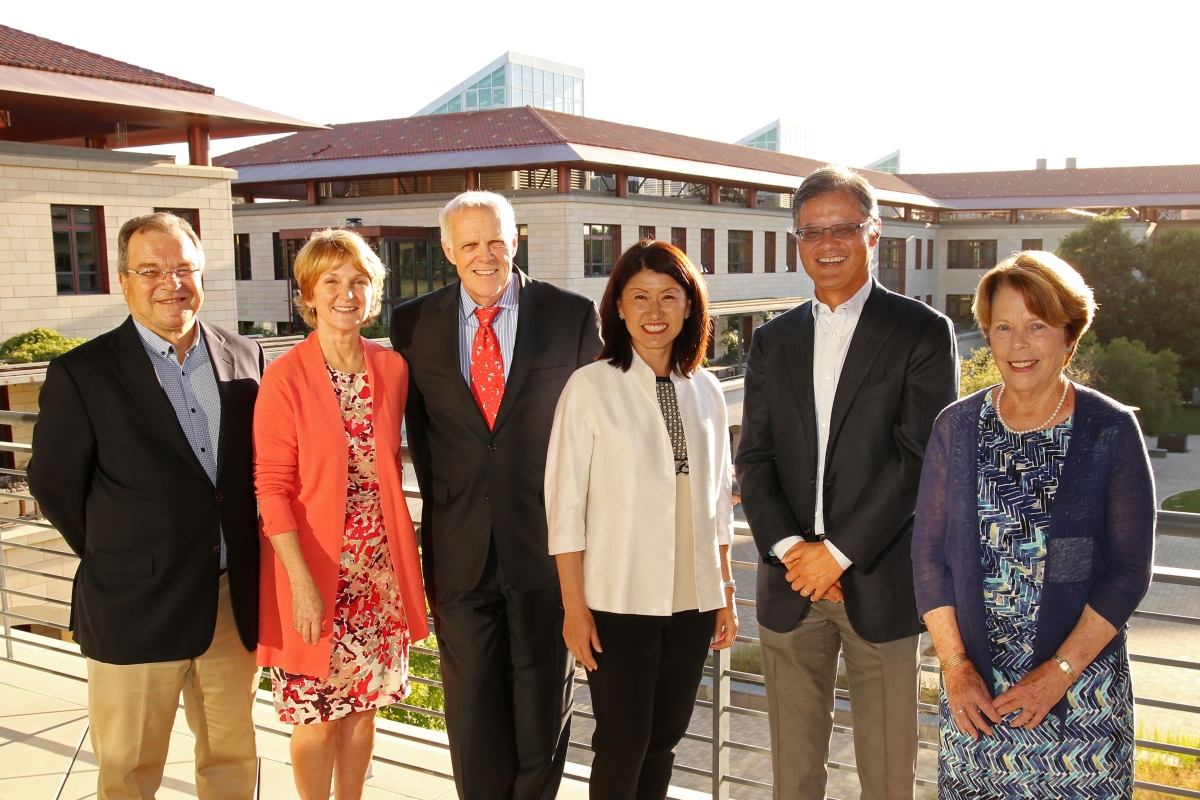
Thanks for your support and interest in Stanford's pursuit of practical solutions for people and planet.
Download a printable PDF of the Stanford Woods Institute for the Environment's Annual Report.

